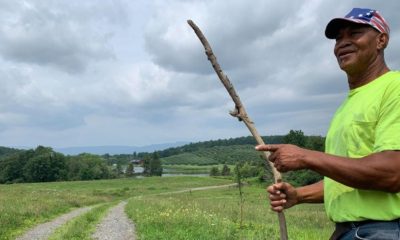Business
Amtrak to Make $90 Million in Renovations to Baltimore’s Penn Station
THE AFRO — Baltimore’s landmark Penn Station, a hub for Amtrak and Marc commuter rail service, is slated to undergo $90 million in renovations, Amtrak announced Thursday.
By Eugene “Jesse” Nash IV
BALTIMORE – Baltimore’s landmark Penn Station, a hub for Amtrak and Marc commuter rail service, is slated to undergo $90 million in renovations, Amtrak announced Thursday.
“By investing in the modernization of Baltimore Penn Station, Amtrak seeks to transform central Baltimore into a premier regional transportation hub that will provide new amenities and transit connections,” said Amtrak President and CEO Richard Anderson. “This work is part of Amtrak’s ongoing efforts to improve the customer experience and grow passenger rail.”
Maryland lawmakers applauded the announcement.
“Commuters throughout Maryland rely on Baltimore Penn Station every day,” Sens. Ben Cardin and Chris Van Hollen, both Democrats, said in a joint statement. “This funding will make necessary updates to improve the lives of those who live and work in our community.”
“We’re glad to see this significant investment in the station, and we will continue working in the Senate to modernize infrastructure across our state,” the senators added.
Democratic Rep. Elijah Cummings, who lives in the city, praised the agency’s efforts to improve the community around the station.
“I am very excited about this partnership, & I applaud Amtrak for their financial commitment to the revitalization of Penn Station,” the congressman tweeted. “I look forward to working with Amtrak, Penn Station Partners, & the Baltimore community to ensure that this project reflects our local priorities.”
The station sees more than a million passengers a year, according to Amtrak.
The plans are to “expand and modernize” the century-old structure at the heart of Baltimore, Amtrak said.
The nation’s eighth-busiest Amtrak station will see new bike and walking paths and the addition of parking spaces, according to development vision concepts released by the assigned developers, Penn Station Partners. The development group is comprised of around a dozen consulting, design and construction firms.
As part of the planned renovations, one of the existing platforms will be redone and a new platform will be added. Plans so far have envisioned preserving the existing historic structure.
Developers are going to lease neighboring land to build a mixed-use project that will include apartments, shops and offices.
From the conception of the project, developers involved have turned to the community for recommendations, holding a public forum last July.
“This is an important project for the city of Baltimore and one that we need to get right,” Michael Beatty, president of Beatty Development Group, one of the contractors involved, said in a statement.
Residents of the surrounding Mount Vernon neighborhood told developers in July that they wanted improvements to the station that would help foster a sense of community in the area. Suggestions included a public playground, art pieces, and a basketball court, according to a summary report.
Penn Station Partners acknowledged the comments but has not given detailed plans for the renovations yet.
This update comes on the heels of reconstruction to the other central train station in the city, Camden Station, which began in Fall 2018. Renovations to Camden Station are expected to be completed this summer, according to a Marc statement.
This article originally appeared in The Afro.
Alameda County
Seth Curry Makes Impressive Debut with the Golden State Warriors
Seth looked comfortable in his new uniform, seamlessly fitting into the Warriors’ offensive and defensive system. He finished the night with an impressive 14 points, becoming one of the team’s top scorers for the game. Seth’s points came in a variety of ways – floaters, spot-up three-pointers, mid-range jumpers, and a handful of aggressive drives that kept the Oklahoma City Thunder defense on its heels.

By Y’Anad Burrell
Tuesday night was anything but ordinary for fans in San Francisco as Seth Curry made his highly anticipated debut as a new member of the Golden State Warriors. Seth didn’t disappoint, delivering a performance that not only showcased his scoring ability but also demonstrated his added value to the team.
At 35, the 12-year NBA veteran on Monday signed a contract to play with the Warriors for the rest of the season.
Seth looked comfortable in his new uniform, seamlessly fitting into the Warriors’ offensive and defensive system. He finished the night with an impressive 14 points, becoming one of the team’s top scorers for the game. Seth’s points came in a variety of ways – floaters, spot-up three-pointers, mid-range jumpers, and a handful of aggressive drives that kept the Oklahoma City Thunder defense on its heels.
One of the most memorable moments of the evening came before Seth even scored his first points. As he checked into the game, the Chase Center erupted into applause, with fans rising to their feet to give the newest Warrior a standing ovation.
The crowd’s reaction was a testament not only to Seth’s reputation as a sharpshooter but also to the excitement he brings to the Warriors. It was clear that fans quickly embraced Seth as one of their own, eager to see what he could bring to the team’s championship aspirations.
Warriors’ superstar Steph Curry – Seth’s brother – did not play due to an injury. One could only imagine what it would be like if the Curry brothers were on the court together. Magic in the making.
Seth’s debut proved to be a turning point for the Warriors. Not only did he contribute on the scoreboard, but he also brought a sense of confidence and composure to the floor.
While their loss last night, OKC 124 – GSW 112, Seth’s impact was a game-changer and there’s more yet to come. Beyond statistics, it was clear that Seth’s presence elevated the team’s performance, giving the Warriors a new force as they look to make a deep playoff run.
Activism
Oakland Post: Week of November 26 – December 2, 2025
The printed Weekly Edition of the Oakland Post: Week of November 26 – December 2, 2025

To enlarge your view of this issue, use the slider, magnifying glass icon or full page icon in the lower right corner of the browser window.
Activism
Oakland Post: Week of November 19 – 25, 2025
The printed Weekly Edition of the Oakland Post: Week of November 19 – 25, 2025

To enlarge your view of this issue, use the slider, magnifying glass icon or full page icon in the lower right corner of the browser window.
-

 Activism3 weeks ago
Activism3 weeks agoOakland Post: Week of November 12 – 18, 2025
-

 Activism3 weeks ago
Activism3 weeks agoIN MEMORIAM: William ‘Bill’ Patterson, 94
-

 Activism3 weeks ago
Activism3 weeks agoHow Charles R. Drew University Navigated More Than $20 Million in Fed Cuts – Still Prioritizing Students and Community Health
-

 Bay Area3 weeks ago
Bay Area3 weeks agoNo Justice in the Justice System
-

 #NNPA BlackPress3 weeks ago
#NNPA BlackPress3 weeks agoLewis Hamilton set to start LAST in Saturday Night’s Las Vegas Grand Prix
-

 #NNPA BlackPress2 weeks ago
#NNPA BlackPress2 weeks agoBeyoncé and Jay-Z make rare public appearance with Lewis Hamilton at Las Vegas Grand Prix
-

 Activism2 weeks ago
Activism2 weeks agoOakland Post: Week of November 19 – 25, 2025
-

 #NNPA BlackPress3 weeks ago
#NNPA BlackPress3 weeks agoThe Perfumed Hand of Hypocrisy: Trump Hosted Former Terror Suspect While America Condemns a Muslim Mayor

























































